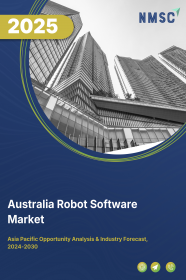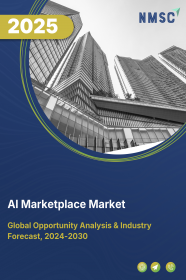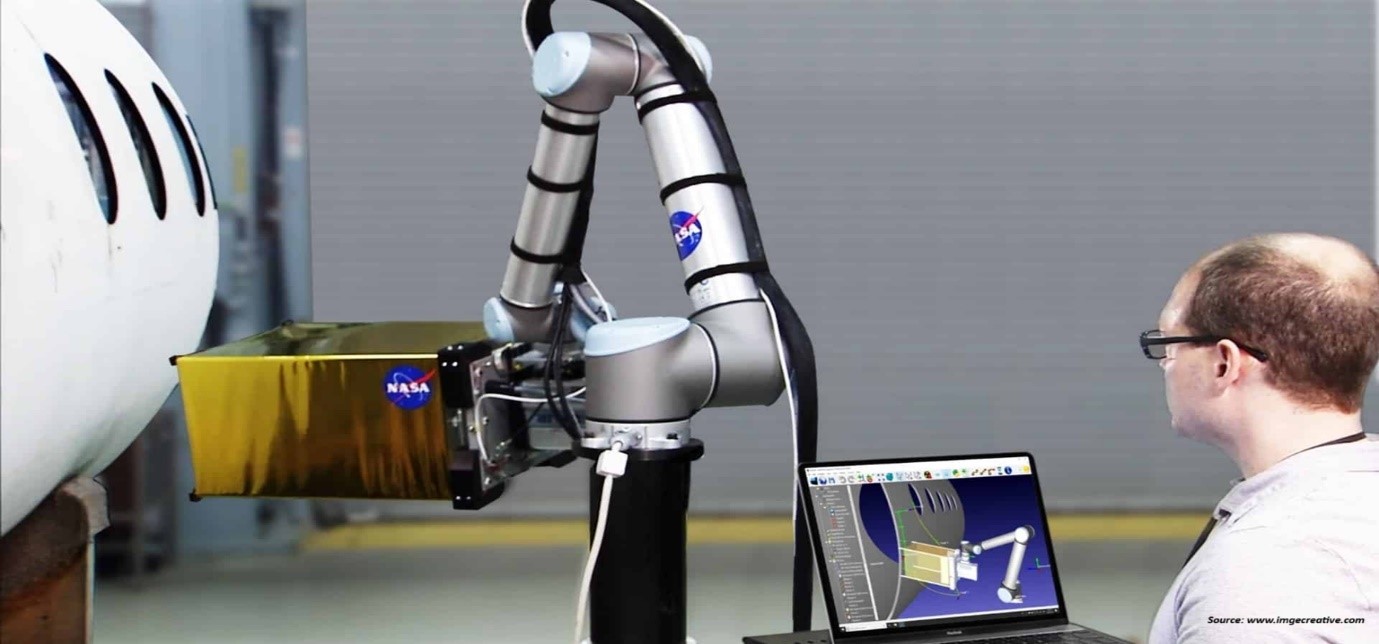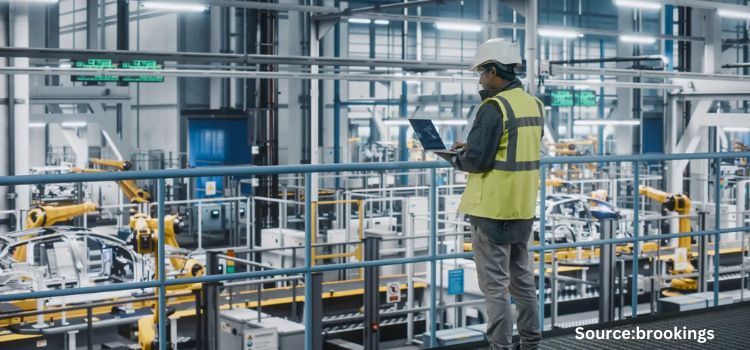
Australia Robot Software Market by Software Type (Recognition Software, Simulation Software, Predictive Maintenance Software, Communication Management Software, and Data Management and Analysis Software), by Robot Type (Service Robots and Industrial Robots), by Deployment Mode (On-premise and On-demand), by Organization Size (Large Enterprises and Small and Medium-sized Enterprises (SMEs) – Opportunity Analysis and Industry Forecast, 2024–2030
Industry: ICT & Media | Publish Date: 14-Feb-2025 | No of Pages: 126 | No. of Tables: 92 | No. of Figures: 57 | Format: PDF | Report Code : IC2394
US Tariff Impact on Australia Robot Software Market
Trump Tariffs Are Reshaping Global Business
Australia Robot Software Market Overview
The Australia Robot Software Market size was valued at USD 107.6 million in 2023, and is expected to reach USD 763.5 million by 2030, with a CAGR of 31.1% from 2024 to 2030. Robot software comprises a suite of programs and algorithms designed to oversee and control the operations of robots or robotic systems across various industries such as logistics, manufacturing, entertainment, healthcare, and more.
Its functionality involves several key components. Firstly, it manages and coordinates the movements and behaviors of robots, ensuring precise and efficient task execution by issuing detailed commands to robotic components such as motors and actuators. Additionally, robot software plays a critical role in interpreting data from diverse sensors embedded within robots, including cameras, Light Detection and Ranging (LIDAR) sensors, and tactile sensors, providing essential environmental feedback enabling robots to perceive and understand their surroundings.
An essential aspect of robot software is its ability to make intelligent decisions using artificial intelligence (AI) and machine learning (ML) algorithms. By analyzing data from sensors, adhering to predefined rules, or learning from past experiences, robots can adapt to changing conditions, enabling them to operate autonomously and adjust their actions in real-time. Furthermore, robot software facilitates communication and networking between robots, allowing collaboration for complex tasks or data exchange with a central control system. This interconnectedness enables synchronized operations in industrial robots, leading to enhanced efficiency and productivity.
Increasing Investments in Research and Development (R&D) Drive the Australia Robot Software Market Growth
Increasing investments in research and development (R&D) play a crucial role in driving the Australia robot software market growth in the country. As organizations and governments allocate more resources to R&D initiatives, there is a heightened focus on advancing robotics and automation technologies, including robot software.
These investments serve as catalysts for innovation, leading to the development of more sophisticated and capable robot software solutions. R&D efforts significantly contribute to enhancing functionalities such as AI integration, machine learning algorithms, and advanced control systems, enabling robots to perform complex tasks with greater efficiency and autonomy.
Moreover, R&D investments fuel the exploration of new applications and use cases for robot software across diverse industries, expanding the market's potential. By fostering technological advancements and addressing emerging challenges, increased R&D investments stimulate market growth and drive the evolution of the industrial robots.
Rising Labor Costs and Workforce Challenges Drive the Growth of the Australia Robot Software Market
Escalating labor expenses and the ongoing challenges in securing a competent workforce significantly drive the Australia robot software market expansion in the country. As the costs of labor continue to soar, particularly within industries heavily reliant on labor-intensive tasks, organizations are actively seeking solutions to curtail expenses while maintaining productivity levels.
This inclination stimulates widespread adoption of automation technologies, including robots, to streamline operations and reduce dependence on human labor. The crux of this adoption lies in the pivotal role performed by robot software, facilitating efficient programming, control, and optimization of robotic systems.
Furthermore, workforce challenges such as skill shortages and demographic shifts serve as additional incentives for businesses to invest in robot software solutions, ensuring uninterrupted operations and competitiveness. Consequently, the Robot Software Market enjoys sustained growth as organizations increasingly turn to automation to combat labor-related challenges and enhance operational efficiency.
High Initial Investment for Acquiring Robot Hardware Restrain the Australia Robot Software Market
The significant upfront investment needed to procure robot hardware poses a notable obstacle to the Australia robot software market demand in the country. Acquiring robot hardware entails substantial initial costs, including the purchase of robotic systems, peripherals, and related equipment.
These expenditures can be prohibitive for numerous organizations, particularly small and medium-sized enterprises (SMEs) or those with limited financial resources. The substantial financial commitment required for robot hardware may dissuade potential adopters from investing in robot software solutions, despite recognizing their potential long-term benefits.
Moreover, the high initial investment can prolong the return on investment (ROI) period, resulting in lengthier payback periods and constraining the scalability of robot deployments. Consequently, addressing the issue of high initial investment costs for robot hardware is pivotal to unlocking broader adoption and fostering the Australia robot software market growth.
Development of Digital Twins and Simulation Software Creates New Opportunities in the Australia Robot Software Market
The emergence of digital twins and simulation software creates fresh opportunities in the Australia robot software market by providing advanced tools for modeling, testing, and optimizing robotic systems in the country. Digital twins generate virtual replicas of physical robots and their surroundings, facilitating real-time monitoring, analysis, and predictive maintenance.
Simulation software enables users to simulate different scenarios and environments, validating robot software algorithms and enhancing performance before deployment. These technologies offer notable benefits, such as reduced development time and costs, improved scalability, and enhanced risk management.
Furthermore, digital twins and simulation software support collaborative development and training, enabling stakeholders to iterate and refine robot software solutions more efficiently. By furnishing robust tools for design, testing, and optimization, the emergence of digital twins and simulation software fuels innovation and expedites the adoption of robot software across various industries.
Competitive Landscape
Several market key players operating in the Australia robot software industry include IBM, NVIDIA, ABB Ltd., FANUC, Teradyne, Inc., H2O.ai, Brain Corp, CloudMinds, Clearpath Robotics, and Neurala, Inc. These market players are adopting strategies to maintain their dominance in the market.
Australia Robot Software Market Key Segments
By Software Type
-
Recognition Software
-
Simulation Software
-
Predictive Maintenance Software
-
Communication Management Software
-
Data Management and Analysis Software
By Robot Type
-
Service Robots
-
Ground
-
Aerial
-
Underwater
-
-
Industrial Robots
-
Traditional Industrial Robots
-
Articulated Robots
-
SCARA Robots
-
Parallel Robots
-
Cartesian Robots
-
Other Robots
-
-
Collaborative Industrial Robots
-
By Deployment Mode
-
On-premise
-
On-demand
By Organization Size
-
Large Enterprises
-
Small and Medium-sized Enterprises (SMEs)
By Industry Vertical
-
Banking, Financial Services, and Insurance (BFSI)
-
Automotive
-
Retail and eCommerce
-
Aerospace & Defense
-
Healthcare and Life Sciences
-
Transportation and Logistics
-
Manufacturing
-
Telecommunications and IT
-
Academia and Research
-
Media & Entertainment
-
Others
REPORT SCOPE AND SEGMENTATION:
|
Parameters |
Details |
|
Market Size in 2023 |
USD 107.6 Million |
|
Revenue Forecast in 2030 |
USD 763.5 Million |
|
Growth Rate |
CAGR of 31.1% from 2024 to 2030 |
|
Analysis Period |
2023–2030 |
|
Base Year Considered |
2023 |
|
Forecast Period |
2024–2030 |
|
Market Size Estimation |
Million (USD) |
|
Growth Factors |
|
|
Companies Profiled |
10 |
|
Market Share |
Available for 10 companies |
|
Customization Scope |
Free customization (equivalent up to 80 working hours of analysts) after purchase. Addition or alteration to country, regional, and segment scope. |
|
Pricing and Purchase Options |
Avail customized purchase options to meet your exact research needs. |
KEY PLAYERS
-
IBM
-
NVIDIA
-
ABB Ltd.
-
FANUC
-
Teradyne, Inc.
-
H2O.ai
-
Brain Corp
-
CloudMinds
-
Clearpath Robotics
-
Neurala, Inc.

















 Speak to Our Analyst
Speak to Our Analyst





















